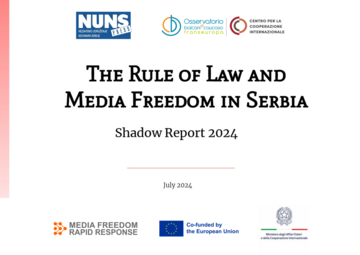
On July 24, the European Commission published its annual Rule of Law reports through which it monitors rule of law developments across the European space and provides recommendations calling on competent national authorities to promptly address and solve potential risks. One of the four sections that compose the reports is dedicated to media freedom and pluralism and addresses a set of media-related issues ranging from the legislative framework, and public service media, to journalists' safety and the functioning of the media market.
This year, for the first time, the European Commission involved some candidate countries in its rule of law mechanism: the Rule of Law Reports for candidates such as Serbia will thus complement and inform the traditional Progress Reports that the European Commission usually publishes towards the end of each year.
Intending to contribute to the EU Commission Rule of Law monitoring exercise, IJAS and OBCT have prepared a Shadow Report that provides an updated and comprehensive analysis of the Serbian media landscape, pointing out not only positive steps forward but above all remaining and emerging challenges that need to be addressed. The report also includes a set of recommendations addressed both to national authorities and relevant civic associations, urging them to take action and strengthen their commitment to the protection of media freedom in line with European and international standards.
English:
Serbo-Croatian:
This pubblication is the result of activities carried out within the Media Freedom Rapid Response and within ATLIB - Transnational Advocacy for Freedom of Information in the Western Balkans, a project co-funded by the Italian Ministry of Foreign Affairs and International Cooperation. All opinions expressed represent the views of their author and not those of the co-funding institutions.
Tags: Serbia Media freedom Rule of Law
This content is part of the Media Freedom Rapid Response (MFRR), a Europe-wide mechanism which tracks, monitors and responds to violations of press and media freedom in EU Member States and Candidate Countries. The project is co-funded by the European Commission.


